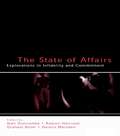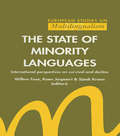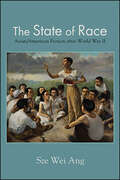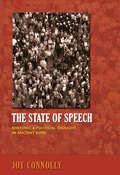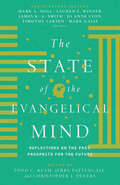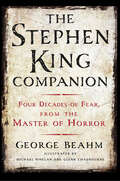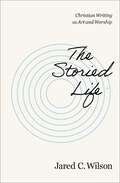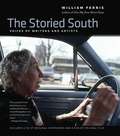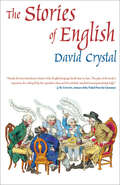- Table View
- List View
The State of Affairs: Explorations in infidelity and Commitment (LEA's Series on Personal Relationships)
by Jean Duncombe, Kaeren Harrison, Graham Allan and Dennis MarsdenThis volume brings together contributions on the study of sexual affairs in committed personal relationships. The editors enlisted colleagues with varied theoretical and methodological perspectives from Britain, the United States, and other countries. Together, their contributions provide a broad, cross-national perspective on affairs. Grounded in theoretical discussion, the chapters in this book introduce data collected by a broad range of methods, including attitude surveys, large statistical cohort studies, case studies, depth interviews, and group discussions. A number of contributors locate the theoretical discussion of affairs within the broader contemporary ordering of committed relationships, contrasting the liberating and empowering aspects of affairs with the damage they may inflict on society as a whole and on the lives of individuals and families. The themes of passion, transgression, secrecy, lies, betrayal, and gossip are common to a range of chapters throughout. The volume provides broad literature reviews and theoretical discussions concerning particular aspects of affairs, such as communication and jealousy. In addition, case studies are used for the more detailed exploration of heterosexual affairs and contemporary developments in gay male and lesbian relationships. The State of Affairs will be of interest to researchers, scholars, and students in social psychology; communication; sociology; family, social, and clinical psychology; and for practitioners in couple counseling.
The State of Asian Communication Research and Directions for the 21st Century
by Ran WeiThe 21st century has been called ‘the Asian Century’ by Eastern and Western academics, largely due to the economic and cultural rise of China and India. This volume explores both what this means for communication research, and the implications of Asia’s rising global power for communication scholars in Asia and from around the world. Hot topics and emerging trends are explored, encapsulating the new opportunities as well as the challenges for Asian communication scholars. Asia represents diverse cultural, economic, social and political systems that shape different media systems in various countries with fertile contexts for communication research. The scope of the chapters in this book includes mass communications, mobile technology, intercultural and political communication, news and entertainment, health communication, public relations, and comparative analyses of mainstream mass communication theories. The articles in this book were originally published in the Asian Journal of Communication.
The State of Minority Languages
by Sjaak KroonMany regional languages across the world are threatened by modernization and urbanization whilst the universal and rapid rise of migration has created new and unprecedented forms of multilingualism. Aspects of education, national policies and attitudes towards minority languages are documented.
The State of Public Bureaucracy (Bureaucracies, Public Administration, And Public Policy Ser.)
by Larry B. HillThe authors explore the many ways that gender and communication intersect and affect each other. Every chapter encourages a consideration of how gender attitudes and practices, past and current, influence personal notions of what it means not only to be female and male, but feminine and masculine. The second edition of this student friendly and accessible text is filled with contemporary examples, activities, and exercises to help students put theoretical concepts into practice.
The State of Race: Asian/American Fiction after World War II (SUNY series in Multiethnic Literatures)
by Sze Wei AngContemporary ideas about race are often assumed to be products of specific locales and histories, yet we find versions of the same ideas about race across countries and cultures. How can we account for this paradox? In The State of Race, Sze Wei Ang argues that globalization has led to new ways of using racial stereotypes as shorthand for complex social relations in disparate national contexts. Literature then provides a key to understanding these labels and the role that race has played in shoring up state power since World War II. Ang contends that in an era marked by global economic dependence, the nation-state has only become more rather than less central to organizing social life via tropes of race that cast human and cultural differences in morally charged terms. Focusing on a series of Asian American and Malaysian texts, Ang tracks the significance of two figures in particular—the model minority and the communist spy. Appearing in novels, politics, and popular culture, these stereotypes anchor powerful narratives about race, global capital, and state sovereignty. In exploring the United States and Malaysia, two countries that seem to not have much in common, Ang reveals how they share very similar ways of conceptualizing race and sheds light on an emerging global story of value.
The State of Scholarly Publishing: Challenges and Opportunities
by Harold LaskiFor decades, university presses and other scholarly and professional publishers in the United States played a pivotal role in the transmission of scholarly knowledge. Their books and journals became the "gold standard" in many academic fields for tenure, promotion, and merit pay. Their basic business model was successful, since this diverse collection of presses had a unique value proposition. They dominated the scholarly publishing field with preeminent sales in three major markets or channels of distribution: libraries and institutions; college and graduate school adoptions; and general readers (i.e., sales to general retailers).Yet this insulated world changed abruptly in the late 1990s. What happened? This book contains a superb series of articles originally published in The Journal of Scholarly Publishing, by some of the best experts on scholarly communication in the western hemisphere, Europe, Asia, and Africa. These authors analyze in depth the diverse and exciting challenges and opportunities scholars, universities, and publishers face in what is a period of unusual turbulence in scholarly publishing.The topics given attention include: copyrights, the transformation of scholarly publishing from a print format to a digital one, open access, scholarly publishing in emerging nations, problems confronting journals, and information on how certain academic disciplines are coping with the transformation of scholarly publishing. This book is a must read for anyone interested in the scholarly publishing industry's past, its current focus, or future plans and developments.
The State of Speech: Rhetoric and Political Thought in Ancient Rome
by Joy ConnollyRhetorical theory, the core of Roman education, taught rules of public speaking that are still influential today. But Roman rhetoric has long been regarded as having little important to say about political ideas. The State of Speech presents a forceful challenge to this view. The first book to read Roman rhetorical writing as a mode of political thought, it focuses on Rome's greatest practitioner and theorist of public speech, Cicero. Through new readings of his dialogues and treatises, Joy Connolly shows how Cicero's treatment of the Greek rhetorical tradition's central questions is shaped by his ideal of the republic and the citizen. Rhetoric, Connolly argues, sheds new light on Cicero's deepest political preoccupations: the formation of individual and communal identity, the communicative role of the body, and the "unmanly" aspects of politics, especially civility and compromise. Transcending traditional lines between rhetorical and political theory, The State of Speech is a major contribution to the current debate over the role of public speech in Roman politics. Instead of a conventional, top-down model of power, it sketches a dynamic model of authority and consent enacted through oratorical performance and examines how oratory modeled an ethics of citizenship for the masses as well as the elite. It explains how imperial Roman rhetoricians reshaped Cicero's ideal republican citizen to meet the new political conditions of autocracy, and defends Ciceronian thought as a resource for contemporary democracy.
The State of Theory
by Richard BradfordFirst published in 1993. Routledge is an imprint of Taylor & Francis, an informa company.
The State of the Evangelical Mind: Reflections on the Past, Prospects for the Future
by Mark A. Noll Timothy Larsen Lauren F. Winner Mark Galli Richard J. Mouw James K. Smith David C. Mahan Jo Anne Lyon C. Donald SmedleyScandal of the Evangelical MindRichard J. MouwMark A. NollJo Anne LyonDavid C. Mahan and C. Donald SmedleyTimothy LarsenLauren WinnerJames K. A. SmithMark GalliThe State of the Evangelical Mind
The Stationers' Company and the Printers of London, 1501-1557
by Peter W. M. BlayneyThis major, revisionist reference work explains for the first time how the Stationers Company acquired both a charter and a nationwide monopoly of printing. In the most detailed and comprehensive investigation of the London book trade in any period, Peter Blayney systematically documents the story from 1501, when printing first established permanent roots inside the City boundaries, until the Stationers' Company was incorporated by royal charter in 1557. Having exhaustively re-examined original sources and scoured numerous archives unexplored by others in the field, Blayney radically revises accepted beliefs about such matters as the scale of native production versus importation, privileges and patents, and the regulation of printing by the Church, Crown, and City. His persistent focus on individuals - most notably the families, rivals, and successors of Richard Pynson, John Rastell, and Robert Redman - keeps this study firmly grounded in the vivid lives and careers of early Tudor Londoners.
The Steampunk Bible: An Illustrated Guide to the World of Imaginary Airships, Corsets and Goggles, Mad Scientists, and Strange Literature
by Jeff VanderMeer“Wonderful essays on everything steampunk, written by well-known names in the movement who are living steampunk every day” (Wired.com).Steampunk—a grafting of Victorian aesthetic and punk rock attitude onto various forms of science-fiction culture—is a phenomenon that has come to influence film, literature, art, music, fashion, and more. The Steampunk Bible is the first compendium about the movement, tracing its roots in the works of Jules Verne and H. G. Wells through its most recent expression in movies such as Sherlock Holmes. Its adherents celebrate the inventor as an artist and hero, re-envisioning and crafting retro technologies including antiquated airships and robots. A burgeoning DIY community has brought a distinctive Victorian-fantasy style to their crafts and art. Steampunk evokes a sense of adventure and discovery, and embraces extinct technologies as a way of talking about the future. This ultimate manual will appeal to aficionados and novices alike as author Jeff VanderMeer takes the reader on a wild ride through the clockwork corridors of Steampunk history.Praise for The Steampunk Bible“An informed, informative and beautifully illustrated survey of the subject.” —The Financial Times“The Steampunk Bible is far and away the most intriguing catalog of all things steam yet written.” —The Austin Chronicle
The Stephen King Companion: Four Decades of Fear from the Master of Horror
by George BeahmThe Stephen King Companion is an authoritative look at horror author King's personal life and professional career, from Carrie to The Bazaar of Bad Dreams. King expert George Beahm, who has published extensively about Maine's main author, is your seasoned guide to the imaginative world of Stephen King, covering his varied and prodigious output: juvenalia, short fiction, limited edition books, bestselling novels, and film adaptations. The book is also profusely illustrated with nearly 200 photos, color illustrations by celebrated "Dark Tower" artist Michael Whelan, and black-and-white drawings by Maine artist Glenn Chadbourne.Supplemented with interviews with friends, colleagues, and mentors who knew King well, this book looks at his formative years in Durham, when he began writing fiction as a young teen, his college years in the turbulent sixties, his struggles with early poverty, working full-time as an English teacher while writing part-time, the long road to the publication of his first novel, Carrie, and the dozens of bestselling books and major screen adaptations that followed.For fans old and new, The Stephen King Companion is a comprehensive look at America's best-loved bogeyman.
The Stillbirth of Capital: Enlightenment Writing and Colonial India
by Siraj AhmedThis book targets one of the humanities' most widely held premises: namely, that the European Enlightenment laid the groundwork for modern imperialism. It argues instead that the Enlightenment's vision of empire calls our own historical and theoretical paradigms into question. While eighteenth-century British India has not received nearly the same attention as nineteenth- and twentieth-century empires, it is the place where colonial rule and Enlightenment reason first became entwined. The Stillbirth of Capital makes its case by examining every work about British India written by a major author from 1670 to 1815, a period that coincides not only with the Enlightenment but also with the institution of a global economy. In contrast to both Marxist and liberal scholars, figures such as Dryden, Defoe, Voltaire, Sterne, Smith, Bentham, Burke, Sheridan, and Scott locate modernity's roots not in the birth of capital but rather in the collusion of sovereign power and monopoly commerce, which used Indian Ocean wealth to finance the unfathomable costs of modern war. Ahmed reveals the pertinence of eighteenth-century writing to our own moment of danger, when the military alliance of hegemonic states and private corporations has become even more far-reaching than it was in centuries past.
The Stoic Origins of Erasmus' Philosophy of Christ
by Ross DealyThis original and provocative engagement with Erasmus’ work argues that the Dutch humanist discovered in classical Stoicism several principles which he developed into a paradigm-shifting application of Stoicism to Christianity. Ross Dealy offers novel readings of some lesser and well-known Erasmian texts and presents a detailed discussion of the reception of Stoicism in the Renaissance. In a considered interpretation of Erasmus’ De taedio Iesu, Dealy clearly shows the two-dimensional Stoic elements in Erasmus’ thought from an early time onward. Erasmus’ genuinely philosophical disposition is evidenced in an analysis of his edition of Cicero’s De officiis. Building on stoicism Erasmus shows that Christ’s suffering in Gethsemane was not about the triumph of spirit over flesh but about the simultaneous workings of two opposite but equally essential types of value: on the one side spirit and on the other involuntary and intractable natural instincts.
The Stones of Venice (Lorenzo Da Ponte Italian Library)
by John RuskinIn the early 1850s, John Ruskin published The Stones of Venice, a history of Venetian architecture. He asserted the moral and aesthetic superiority of Venice’s medieval buildings over structures from the Renaissance period. Ruskin’s engaging and beautifully crafted prose inspired his Anglo-American readers to travel to Venice, to construct Gothic Revival buildings in their own cities, and to critically examine the moral virtues of modern society and how those principles are reflected in modern architecture. Since 1904, only abridged editions of The Stones of Venice have been published – all of which sacrifice Ruskin’s didacticism in favour of the aestheticism of a few select passages. As the first unabridged edition in over a century, this book restores the context for those selections. It retains Ruskin’s tripartite history of Venice and includes material omitted from abridged versions, including Ruskin’s supplementary folio. It features reproductions of many of Ruskin’s original sketches, which in previous editions appeared only as engraved copies. This edition includes his list of Venice’s most important buildings, with endnotes updating their contemporary status, as well as an appendix with selections from other Venetian-themed texts by Ruskin. Introducing new readers to an important literary figure, this book also features an introductory essay that situates The Stones of Venice within John Ruskin’s life and writings.
The Storied Life: Christian Writing as Art and Worship
by Jared C. WilsonWhen writers write, they are getting in touch with the image of God in them. This is true in some way of all artistry, but writers especially create worlds, characters, histories, and transformation--all ex nihilo ("out of nothing").In The Storied Life, veteran author Jared C. Wilson explores the ins and outs of writers and writing, exploring the myriad ways the craft is more about transformation than simply communication. From decades of experience and with his signature wit, Wilson brings well-earned insight, autobiographical reflections, and meaningful meditations to the topic of writing as a way of life and as a way of worship, showing how the concept of Story--our personal stories and God's grand story of redemption--shapes fiction and non-fiction writers alike.Chapters focus on topics like:The liturgy of story.Writing as a spiritual act.Perseverance and endurance.Writing as a calling.Promotion, publishing, and platform.Whether you're a long-time writer or a beginning author, a daily journaler or an occasional dabbler, The Storied Life will help you improve your craft. It will lead you to think more deeply about the disciplines and dispositions needed to write for transformation.
The Storied South
by William FerrisThe Storied South features the voices--by turn searching and honest, coy and scathing--of twenty-six of the most luminous artists and thinkers in the American cultural firmament, from Eudora Welty, Pete Seeger, and Alice Walker to William Eggleston, Bobby Rush, and C. Vann Woodward. Masterfully drawn from one-on-one interviews conducted by renowned folklorist William Ferris over the past forty years, the book reveals how storytelling is viscerally tied to southern identity and how the work of these southern or southern-inspired creators has shaped the way Americans think and talk about the South.The Storied South offers a unique, intimate opportunity to sit at the table with these men and women and learn how they worked and how they perceived their art. The volume also features 45 of Ferris's striking photographic portraits of the speakers and a CD and a DVD of original audio and films of the interviews.
The Stories Children Tell: Making Sense of the Narratives of Childhood
by Susan EngelWhether presenting their versions of real events or making up tales of adventure and discovery, children enchant us with their stories. But the value of those stories goes beyond their charm. Storytelling is an essential form through which children interpret their own experiences and communicate their view of the world. Each narrative presented by a child is a brushstroke on an evolving self-portrait - a self-portrait the child can reflect on, refer to, and revise. In The Stories Children Tell, developmental psychologist Susan Engels examines the methods and meanings of children's narratives. She offers a fascinating look at one of the most exciting areas in modern psychology and education. What is really going on when a child tells or writes a story? Engel's insights into this provocative question are drawn from the latest research findings and dozens of actual children's tales - compelling, funny, sometimes disturbing stories often of unexpected richness and beauty. In The Stories Children Tell, Susan Engel examines:- the different functions of storytelling- the way the storytelling process changes as children develop- the contributions of parents and peers to storytelling- the different types of stories children tell- the development of a child's narrative voice- the best way of nurturing a child's storytelling skills Throughout these discussions, Engel presents compelling evidence for what is perhaps her most intriguing idea: that in constructing stories, children are constructing themselves.
The Stories Julian Tells: Instructional Guides For Literature (Julian's World Ser.a\new View Series)
by Ann Cameron Ann StrugnellNIMAC-sourced textbook
The Stories of English: The Persnickety Story Of English Punctuation
by David CrystalA groundbreaking history of worldwide English in all its dialects, differences, and linguistic delights: “Informative . . . distinctive . . . a spirited celebration.” —The GuardianIn this “well-informed and appealing” work (Publishers Weekly), David Crystal puts aside the usual focus on “standard” English, and instead provides a startlingly original view of where the richness, creativity, and diversity of the language truly lies—in the accents and dialects of nonstandard English users all over the world. Whatever their regional, social, or ethnic background, each group has a story worth telling, whether it is in Scotland or Somerset, South Africa or Singapore. He reminds us that for several hundred wonderful years, there was no such thing as “incorrect” English—and traces the evolution of the language from a few thousand Anglo-Saxons to the 1.5 billion people who speak it today.Moving from Beowulf to Chaucer to Shakespeare to Dickens and the present day, Crystal puts regional speech and writing at center stage, giving a sense of the social realities behind the development of English. This significant shift in perspective enables us to understand for the first time the importance of everyday, previously marginalized, voices in our language—and provides an argument too for the way English should be taught in the future.“A work of impeccable scholarship [that] could easily serve as a standard textbook for students of linguistics, but Mr. Crystal, reaching out to a more general audience, recognizes that even the most avid reader might flinch at the sections on Old Norse grammatical influence. Cleverly, he has sprinkled the book with little digressions, set apart in boxes, that address historical mysteries, strange loanwords, interesting etymologies and the like.” —The New York Times“Learned and often provocative . . . demonstrates repeatedly that common conceptions about language are often historically inaccurate—split infinitives bothered no one until recently (likewise sentence-ending prepositions).” —Kirkus Reviews (starred review) “Simply the best introductory history of the English language family that we have. The plan of the book is ingenious, the writing lively, the exposition clear, and the scholarly standard uncompromisingly high.” —J.M. Coetzee, winner of the Nobel Prize in Literature
The Stories of Slang: Language at its most human
by Jonathon Green'By turns bawdy, sweary and irreverent, this book . . . is a fascinating look at how centuries of slang came to inform all aspects of social life, how it was used, and how much of it still lingers.' History RevealedLike the flesh-and-blood humans whose uncensored emotions it represents, slang's obsessions are sex, the body and its functions, and intoxication: drink and drugs. Slang does not do kind. It's about hatreds - both intimate and and national - about the insults that follow on, the sneers and the put-downs. Caring, sharing and compassion? Not at this address. There are over 10,000 terms focusing on sex, but love? Not one.Jonathon Green, aka 'Mr Slang', has drawn on the 600,000-plus citations that make up his magisterial Green's Dictionary of Slang (published 2010, now online at www.greensdictofslang.com) to tell some of slang's most entertaining stories. Categories range from The Body to Pulp Diction, via multi-cultural London English and pun-tastic gems.Mostly gazing up from the gutter, slang, perhaps surprisingly, also embraces the stars. These stories may look at drunken sailors, dubious doctors, and a shelf of dangerously potent cocktails, but slang does class acts as well. None more so than Shakespeare. Devotee of the double entendre, master of the pun, first to put nearly 300 slang terms in print. 'Shakespeare, uses, at my count, just over five hundred "slang" terms, of which 277 are currently the first recorded use of a given term. Among these are the beast with two backs, every mother's son, fat-headed, heifer (for woman), pickers and stealers (hands), small beer (insignificant matters), what the dickens, and many more.'http://jonathongreen.co.uk
The Stories of Slang: Language at its most human
by Jonathon Green'If you're up for an adventure through the back alleys of English, The Stories of Slang will not disappoint.' Kory Stamper, Times Literary Supplement'Few lexicographers are lucky enough to have both endlessly pleasurable work and the talent to write amusingly about [slang]. Jonathon Green is one . . . Lovers of language should be grateful to those who create slang, and to those few like Mr Green who make it their work to open this window into the psyche for the benefit of all.' - The Economist'By turns bawdy, sweary and irreverent, this book . . . is a fascinating look at how centuries of slang came to inform all aspects of social life, how it was used, and how much of it still lingers.' History RevealedLike the flesh-and-blood humans whose uncensored emotions it represents, slang's obsessions are sex, the body and its functions, and intoxication: drink and drugs. Slang does not do kind. It's about hatreds - both intimate and and national - about the insults that follow on, the sneers and the put-downs. Caring, sharing and compassion? Not at this address. There are over 10,000 terms focusing on sex, but love? Not one.Jonathon Green, aka 'Mr Slang', has drawn on the 600,000-plus citations that make up his magisterial Green's Dictionary of Slang (published 2010, now online at www.greensdictofslang.com) to tell some of slang's most entertaining stories. Categories range from The Body to Pulp Diction, via multi-cultural London English and pun-tastic gems.Mostly gazing up from the gutter, slang, perhaps surprisingly, also embraces the stars. These stories may look at drunken sailors, dubious doctors, and a shelf of dangerously potent cocktails, but slang does class acts as well. None more so than Shakespeare. Devotee of the double entendre, master of the pun, first to put nearly 300 slang terms in print. 'Shakespeare, uses, at my count, just over five hundred "slang" terms, of which 277 are currently the first recorded use of a given term. Among these are the beast with two backs, every mother's son, fat-headed, heifer (for woman), pickers and stealers (hands), small beer (insignificant matters), what the dickens, and many more.'http://jonathongreen.co.uk
The Stories of the Ramayana and the Mahabharata: The Great Indian Epics 1899 (Routledge Revivals)
by John Campbell OmanFirst published in 1900, this volume reproduces the key events of the Ramayana and Mahabharata Indian epics. It emerged amongst significant academic interest in Indian culture and literature. Whilst many Indian histories had provided abstracts and full texts of the two epics presented here, this book provided reproductions of the main incidents and striking features of these two otherwise imposing, lengthy works. The volume deals with each text separately and presents several key excerpts along with a general introduction and introductory remarks for both texts.
The Storm (Fountas & Pinnell LLI Green #Level E, Lesson 74)
by Anna MccartFountas and Pinnell Leveled Literacy Intervention Green System -- 1st Grade
The Storm at Sea: Political Aesthetics in the Time of Shakespeare
by Christopher PyeThe Storm at Sea: Political Aesthetics in the Time of Shakespeare counters a tradition of cultural analysis that judges considerations of aesthetic autonomy in the early modern context to be either anachronistic or an index of political disengagement. Pye argues that for a post-theocratic era in which the mise-en-forme of the social domain itself was for the first time at stake, the problem of the aesthetic lay at the very core of the political; it is precisely through its engagement with the question of aesthetic autonomy that early modern works most profoundly explore their relation to matters of law, state, sovereignty, and political subjectivity.Pye establishes the significance of a “creationist” political aesthetic—at once a discrete historical category and a phenomenon that troubles our familiar forms of historical accounting—and suggests that the fate of such an aesthetic is intimately bound up with the emergence of modern conceptions of the political sphere.The Storm at Sea moves historically from Leonardo da Vinci to Thomas Hobbes; it focuses on Shakespeare and English drama, with chapters on Hamlet, Othello, A Winter’s Tale, and The Tempest, as well as sustained readings of As You Like It, King Lear, Thomas Kyd’s Spanish Tragedy, and Christopher Marlowe’s Doctor Faustus. Engaging political thinkers such as Carl Schmitt, Giorgio Agamben, Claude Lefort, and Roberto Esposito, The Storm at Sea will be of interest to political theorists as well as to students of literary and visual theory.
